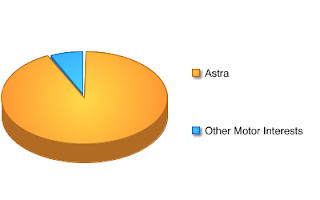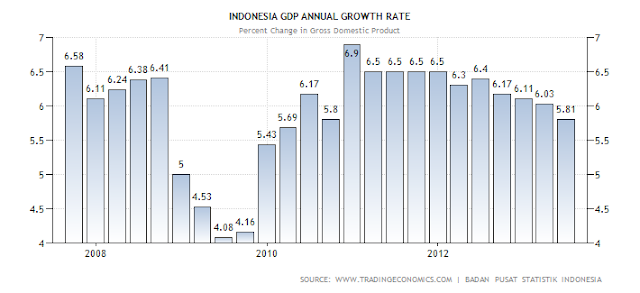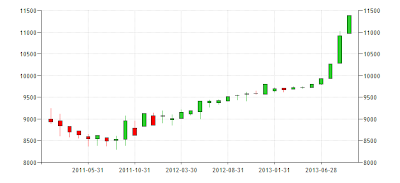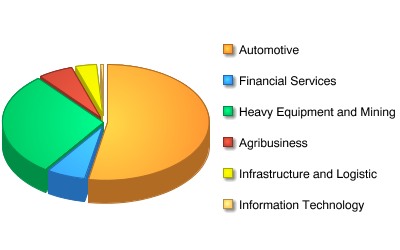We know that much of Jardine’s C&C earnings are dependent almost entirely on how Astra would perform as their earnings contributed 93% of Jardine’s earnings. The other 7% or so would go to the “Other Motor Interests” business they have with Singapore, Malaysia and Vietnam. Therefore, any adverse changes in the political, social, economic and forex situation in Indonesia would have a material impact on Astra’s financial performance, which in turn will have a significant impact on Jardine’s earnings and assets. For the purpose of the analysis, I will concentrate on the Astra segment of the business and ignore the “Other Motor Interest” segment.

|
Indonesia’s Economy and Growth Risk
First, we take a look at how the Indonesian growth has performed over the past few years. A quick glance we will see that 6% is probably the marginal mean line of how the country has performed in the past 5 years or so. Even during the 2008 GFC crisis, we still see growth in the country of around 4+% which I think is impressive for an emerging market. We can see that the trend for 2013 and 2014 are coming down off slightly to less than 6%. This is probably due to money flowing out from the emerging market as well as the election period which we see every 4 years.We’ll probably hit a growth figure similar to the year 2010 in the next 2 years.

Foreign Currency Risk
Since a big segment of the company’s earnings is dependent on its overseas business, we know that foreign currency risk is one that investor has to watch out for. For the earnings, the company has used an exchange rate of USD1: IDR9,419 in 2012 (In 2011, USD1 : IDR8,773). So much sensitivity risk is around such that if the Rupiah depreciates by 10% against the major currencies such as the USD, with all other variables remaining constant, earnings for the Group would have been USD5.3M lower. The Rupiah has to date depreciated to around USD1: IDR11,410, which is almost a 15% drop from 2012.

Astra: Taking a deeper look
Astra’s segments consists of Automotive, Financial Services, Heavy Equipment and Mining, Agribusiness, Infrastructure and Logistics and Information Technology. Here is how they breakdown in terms Astra’s revenue for 2012:

|
|
| Segment | Gross Profit (IDR) in mm |
|---|---|
| Automotive | 11,536,000.0 |
| Financial Services | 7,847,000.0 |
| Heavy Equipment and Mining | 10,521,000.0 |
| Agribusiness | 4,357,000.0 |
| Infrastructure and Logistic | 1,887,000.0 |
| Information Technology | 577,000.0 |

From the above, it is obvious that the automotive segment of the business is the key contributor to Astra’s earnings, contributing more than half the revenue as others. In the past 5 years, the automotive segment has a good growth of over 25% (with exception to 2009 where they had negative growth). It is also obvious that the margins for the business is the lowest among the others, closing in on 11% margins as compared to the others, down from 14% in 2011. For Astra to perform, just feel like the automotive segment has to improve on its margins and it is hard to see that happening in recent economy times.
First, the economy growth in Indonesia seem to be going slightly down in the face of the upcoming election. We see how the automotive segment was hit during the GFC even though Indonesia registered an 4+% growth back then. Secondly, the recent 33% hike in the fuel prices will dampen auto sales even further. Third, with the government recently increasing key interest rates to 7.25 percent in anticipating of rising inflation, it may prompt the automotive business to either report lower margins or having to pass on the increasing costs to consumers. This however, will bring positive news to its financial services segment.
Conclusion
There are so many headwinds right now, across on and off the emerging markets. Locally, Indonesia’s market are always more volatile when elections are looming and facing a potential depreciation in its currency, the government will have to adjust its fiscal policy to increase its interest basis points which will disadvantage the consumer.
Astra share price has dropped from the 52 week high of IDR 8,300 to a recent low of IDR 5,100. It is somewhat similar to Jardine’s price who has dropped from the high of $56 to a low of $31. Both Astra and Jardine have been trading below their average P/E multiples already and there seems yet more headwinds to come. But once the issue is blown over, I feel like this is a stock that we can look out for. But for now, the risks are pretty much there on the table.

